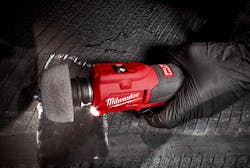Cordless tools add safety, productivity to car repairs
Customers don’t see your tools in action, but they see your repair outcomes. Your shop’s efficiency, along with the overall health of your business, can benefit from using cordless tools.
Today’s mechanics can use cordless tools equipped with electronics to service cars that now routinely have electronics. It’s a new era in service centers.
Cordless hand tools that are strong, lightweight, and compact enough to reach all automotive angles are relatively new to the marketplace. In 2005, Milwaukee Tool® invented the technology to power tools with lithium-ion batteries, leading to a fundamental shift in cordless tool technology. As battery-powered tools have advanced with longer-life batteries, there is new awareness and readiness for the benefits of utilizing these in shop environments. Cordless impact wrenches (stubby, mid-torque, and high torque), ratchets, die grinders, rivet guns, drills, tire buffers, polishers, and cut-off tools are being put to work safely and productively in repair and collision shops.
Cordless tools are driving immense growth in the tool industry today. We’ve been able to leverage this battery-powered technology to deliver solutions that satisfy technicians at all sizes of automotive service providers. We want technicians to have the right tool for the job and that why we offer so many choices.
With all that said, some users have been slower to adopt the benefits of cordless technology for underhood service, body work, tire and wheel service, brakes, and under-car service, as well as collision repair. It’s not surprising. Changing the way work gets done can be difficult, but the perception around cordless continues to change as many more shops start integrating these tools into their business.
PRODUCTIVITY GAINS
In today’s business climate, customers view a car repair like a pit stop in a professional auto race. They care about time efficiency and getting back on the road. Productivity means profit to technicians in service shops. Speed is important to technicians paid on the flat-rate system. They need to finish work efficiently and pay attention to time estimates. To a technician keeping track of time, productivity gains outweigh any extra upfront costs.
Along with time savings, mobility is an improvement. Technicians using cordless tools enjoy easy freedom in workflow. They can walk anywhere in the shop or even out to the parking lot to work, without losing their momentum.
Time is also gained, allowing other work to get done. Daily tool maintenance is reduced; technicians just need to charge the battery.
We’re trying to help technicians get what they value the most. We’re making cordless tools that fit seamlessly into the automotive world because we spend time in the shop with the technicians.
We know high quality is important to technicians; the standard of quality in tools has increased and so have the expectations of users. Since mechanics pay for their own tools, it makes sense for them to pay for a tool that gives them the features they want.
Newer cordless tools include:
- Brushless motors. Quickly becoming the standard, brushless motors offer cooler performance using less energy. They require less maintenance and offer more power and longer run-time. Without the friction of brushed motors, there is no heat buildup or reduced speed.
- 21700 batteries. Milwaukee uses 21700 battery cells in the M12 and M18 High Output systems. The 21700s, a form of which can be found powering down the road in Teslas, offer more power and more run-time, because they are slightly bigger and longer.
- Bluetooth connectivity. Another advancement quickly becoming the standard, the ONE-KEY platform provides inventory management, tracking to prevent tool theft, and smart or pre-programmable tool solutions. ONE-KEY allows users to control more aspects of the tool with a free smartphone app. Want to adjust RPM, monitor run-time, operate the on-off switch, or disable a tool? Do it remotely.
- Tool settings: Users can adjust power and tightness settings. For instance, Lug Nut Mode prevents the over-fastening of lug nuts by automatically shutting off the tool. Some tools, including the M12 FUEL™ Right Angle Impact Wrench and M12 FUEL™ Right Angle Die Grinder, feature DRIVE CONTROL™ with four settings to prevent overpowering a job. When loosening a bolt, the motor starts off at full power, but as soon as the bolt is free, the motor automatically slows down.
SAFETY ADVANTAGES
In the first quarter of 2020, there were 164,000 auto repair and maintenance centers in the U.S., up 0.8 percent from 2019. Between 2010 and 2020, the industry added more than 6,500 establishments. It’s a struggle to find enough qualified skilled technicians. New personnel join the field every year. Cordless tools add an extra layer of safety for all, but especially for new technicians with less experience in the shop environment.
Slips, trips, and falls, the leading Occupational Safety and Health Administration (OSHA) injury, continued to rise 11 percent in 2019, and all possible diligence is needed to counter the continuing upward trend. Cordless tools help remove this danger.
Getting hit by one of a tool’s attachments, a fastener or even particles flying from the equipment is also a potential safety risk. Cordless tools eliminate this hazard.
Wear and tear on the body, along with overall user fatigue, has brought about the mechanics’ saying: “An ounce in the morning feels like a pound in the afternoon.” Cordless tools are operated with less force and a more temperature consistency, making them great to work with long term. Plus, working all day with an updated cordless tool’s grip adds comfort and avoids cramps in the hands and fingers.
Even in the occupational setting of a service center, hearing loss is preventable. Using quieter cordless tools gives ears a rest. For instance, the M18 FUEL™ High Torque Impact Wrench meets the National Institute for Occupational Safety and Health (NIOSH) noise limit for 8 hours of exposure. It’s 5 decibels under the OSHA standard for 8 hours of exposure.
Many of your competitors are starting to adopt cordless tools due to these benefits and they are satisfied with their choice. We all realize that changing how work is done can be a challenge, but when the payoff is safety of employees, productivity for customers, and the health of the business, it becomes easier to implement cordless tools.



